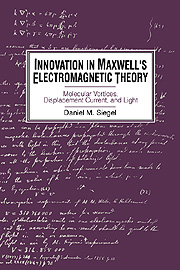Book contents
- Frontmatter
- Contents
- Preface
- Introduction
- 1 The background to Maxwell's electromagnetic theory
- 2 Mechanical image and reality in Maxwell's electromagnetic theory
- 3 The elaboration of the molecular-vortex model
- 4 The introduction of the displacement current
- 5 The origin of the electromagnetic theory of light
- 6 Beyond molecular vortices
- Conclusion
- Appendix 1 Draft of “On Physical Lines of Force,” a fragment
- Appendix 2 Drafts of “A Dynamical Theory of the Electromagnetic Field”
- Appendix 3 Vortex rotations in a curl-free region
- Notes
- Index
3 - The elaboration of the molecular-vortex model
Published online by Cambridge University Press: 24 October 2009
- Frontmatter
- Contents
- Preface
- Introduction
- 1 The background to Maxwell's electromagnetic theory
- 2 Mechanical image and reality in Maxwell's electromagnetic theory
- 3 The elaboration of the molecular-vortex model
- 4 The introduction of the displacement current
- 5 The origin of the electromagnetic theory of light
- 6 Beyond molecular vortices
- Conclusion
- Appendix 1 Draft of “On Physical Lines of Force,” a fragment
- Appendix 2 Drafts of “A Dynamical Theory of the Electromagnetic Field”
- Appendix 3 Vortex rotations in a curl-free region
- Notes
- Index
Summary
As we have seen, Maxwell took the molecular-vortex model quite seriously – with ontological intent – when he first presented it in 1861–2, and although he later lost confidence in certain aspects of the model and removed it to the periphery of his research program, he continued in his allegiance to the core hypothesis of the model – that is, to the hypothesis of molecular vortices. The centrality of the molecular-vortex model in Maxwell's general thinking about electromagnetic theory and the particular importance of this model in the background of the displacement current and the electromagnetic theory of light together provide motivation for a careful study of this intricate mechanical model of the electromagnetic field.
Maxwell's work on the molecular-vortex model was guided, above all, by his desire – his commitment – to fashion a coherent and comprehensive theory unifying the full range of electromagnetic phenomena from the field-primacy point of view. This was required in order to produce a credible alternative to Wilhelm Weber's unification of electromagnetic theory within the charge-interaction framework; comprehensiveness and coherence were required also in connection with the intended realistic status of the theory – Scottish and Cambridge methodologies converged on this requirement.
- Type
- Chapter
- Information
- Innovation in Maxwell's Electromagnetic TheoryMolecular Vortices, Displacement Current, and Light, pp. 56 - 84Publisher: Cambridge University PressPrint publication year: 1992



